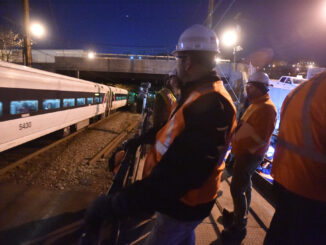NEW YORK — The Metropolitan Transportation Authority Board approved a series of resolutions that will allow the MTA to move forward with fare increases of 25 to 30 percent and service reductions that will affect customers throughout its service area.
These actions were required to implement the balanced budget passed by the Board in December, which closed an approximately $1.2 billion deficit, the board said.
The fare and toll increases will be effective on the following dates:
- New York City Transit, MTA Bus and Long Island Bus (subway, buses and Staten Island Railway): May 31
- Long Island Rail Road and Metro-North Railroad: June 1
- MTA Bridges and Tunnels facilities: July 11
Service reductions will be phased in beginning in May.
“After suffering from decades of political finger pointing and capital starvation, one of the true wonders of the modern world was on the brink of collapse. Deferring fundamental funding decisions and capital investment until next year, or the one after that — or maybe even the one after that — had become routine,” said Dale Hemmerdinger, MTA Chairman. “As a result, a number of other things had become routine: track fires; derailments every 18 days; over 300 subway runs abandoned each day; graffiti; crime. And that was just what the public saw. Much more was at risk behind the scenes: fans, pumps, signals. But it wasn’t just the MTA that was at risk. As our system of buses, subways and railroads became the symbol of urban decay, it was the riders, the workers, the school children, the elderly — it was the born and bred New Yorkers who packed up and left the Empire State — who became the victims.
“If this were a short story, it would have had a terrific ending because in 1982 some very dedicated New Yorkers, here and in the political and business communities, knew how important MTA services were to the region,” Hemmerdinger added. “They figured it out. And they made some tough decisions around this table, in City Hall and in Albany. The result is an MTA that for all its imperfections is arguably the governmental success story of the last generation. Service is better. Service is safer. Service is more reliable. So, people have come back to ride our trains and buses in numbers not seen in half a century. New York — which was left for dead in 1972 — is now seeing its population grow, in large measure because the MTA works and works well.”
The full details of the fare increase and service changes are available at http://mta.info/mta/09/ (Note that the fare scenario passed was Proposal 1).





Why does the MTA always claim they are broke? Since moving to Brooklyn in 2001 the most noticeable changes in the subway system seem to be the elimination of tellers, the elimination of the tokens, and the fare hikes soon to be up to $2.50. I remember when the MTA was caught a few years ago keeping two sets of books, one to display to the public and the media, and the other a secret version showing the MTA had a surplus of cash. In this new economy we cannot continue to fund this type of ruthless corruption. It only takes a few minutes to jot off an email or write a letter to your local congressman and/or senator. In this way you can do more in a few minutes than you could through years of complaining to people that cannot do anything about it.
HappyDogNYC.com